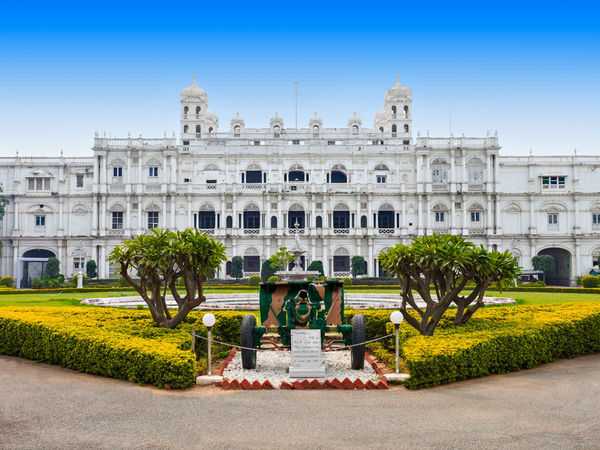
Jai Vilas Palace
About Jai Vilas Palace
Far From City: 2 kms from city center
Cost:
About Jai Vilas Palace
Weather:
Time Required:2-3 hrs
Open Time:April to September: 10:00 AM - 4:45 PM,October to March: 10:00 AM - 4:30 PM (Closed on Wednesdays)
Cost:Indians: INR 100,Foreigner Nationals: INR 600,Camera/Mobile: INR 70,Video Camera: INR 150,Children (up to 5 year
Did you know?
One of the carpets in the palace took around 12 years to weave.
History of Jai Vilas Palace
It was the Maharaja's wish to bring the Palace of Versailles to Gwalior. So, when the occasion arose for King Edward's arrival in the year 1875, he built the Jai Vilas Palace by putting prisoners from the Gwalior fort to work on its construction. Workers spent 12 years fabricating the plush carpet in the main attraction of the Palace - the Durbar Hall. The carpet is one of the largest in the world.
Since setting records seems to be set in stone for this monument, the exquisite chandeliers in the hall are no exception. At that time, experts were doubtful that the roof of the great hall could hold the weight of the two massive chandeliers. However, Sir Michael Filose believed in his approach. In order to prove his point, he set up a wide wooden ramp from the floor to the roof and walked a dozen elephants to the top. The elephants together weighed almost twice that of the chandeliers, and yet the roof held its place. In this way, the ingenious architect simplistically proved the strength of his creation. 140 years later, the roof endures.
Architecture of Jai Vilas Palace
The layout of the Jai Vilas Palace is reflective of the colonial period portraying the strong British influence on India. Designed by the well-known architect Sir Michael Filose (Mukhel Sahib), the magnificent palace is a prime example of European architecture, bringing together myriad experiences the great Sardar had on his tour of the West. The first floor is fashioned in Tuscan style, while the second and third floors are inspired from the Italian-Doric and Corinthian methods respectively. All 400 rooms are furnished with Italian marble flooring, Persian carpets, ornamental accessories and rare antiquities from France, China and Italy.
A unique feature of the Palace is an elongated dining table, on which a silver train with cut glass carriages is rallied around to serve delicacies, after-dinner brandy or cigars to important delegates during get-togethers. The backrests of the chairs at the dining table are emblazoned with the royal crest of Gwalior, indicating the meticulously executed hard work undertaken to beautify the stately home.
Perhaps the most talked-about embellishment is the pair of custom-made chandeliers that Mukhel Sahib ordered from Vienna. Each chandelier is 40 feet high and weighs 3.5 tonnes, the third largest chandeliers in today's world. The late Maharani Vijayraje Scindia, the wife of Maharaja Jayaji Rao Scindia, seemed to be particularly impressed by the chandeliers as she wrote in her autobiography: "Mukhel Saheb (Sir Michael Filose) Sahib saw to it that most of the other things in his palace matched the durbar hall in scale and splendour, and nowhere else is his propensity for the grandiloquent more in evidence than in the crystal chandeliers he ordered for the durbar hall from Vienna. The two main ones which are very nearly a pair are said to be the largest ever made, with the possible exception of the one which hangs in the Czar's winter palace outside Moscow."
H.H. Jiwajirao Scindia Museum
A section of the Jai Vilas Palace consisting of 35 rooms has been converted into a museum by Rajamata Shriman Vijayraje Scindia in memory of the Maharaja Jayaji Rao Scindia. On 12th December 1964, the H.H. Maharaja Sir Jiwajirao Scindia museum was officially opened to the public by the then President of India Dr Sarvapally Radhakrishnan.
Its primary purpose is to serve as a central site for research and learning of ancient Indian arts and culture. Many of the rare artefacts' collections are available for viewing in the main Durbar Hall and beyond. The place includes a museum shop, café and library for recreational pursuits. A provision for specialized tours and services can also be booked, mostly after 5:00 PM that includes high tea and/or dinner at the majestic palace.
How to Reach Jai Vilas Palace
Gwalior is advantageously located in Central India, making it easily accessible via air, rail, and road from all major cities in North and South India. The Jai Vilas Palace is a popular tourist attraction, so a newcomer should not experience too much trouble in finding it. Gwalior has its own airport 8 kilometres northeast of the palace. The nearest railway station is Gwalior Junction, at a distance of 2 km from the attraction. Within the city, one can catch a taxi or city bus to reach the palace. Tourist buses can also drop you at the Jai Vilas Palace for minimal charges.
Top Tourist Places in Gwalior
Jai Vilas Palace
Man Mandir Palace
Gujari Mahal (State Archaeological Museum)
Gwalior Zoo
Teli Ka Mandir
Sun Temple
All Tourist Places in Gwalior
Tips
1. Ensure beforehand that the palace is open at the time you are planning to visit. Occasionally, it may be kept closed for a private gathering of the royal family.2. Make sure to carry lots of drinking water as there is no such facility within the palace grounds.3. There are charges for taking a mobile or camera inside so plan to bring belongings accordingly.
Photos of Jai Vilas Palace
Comments on Jai Vilas Palace
Post Your Comment


























